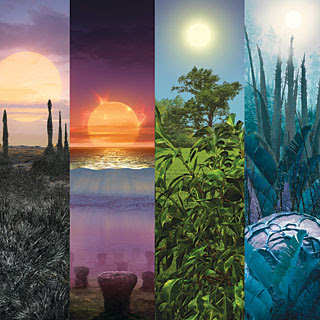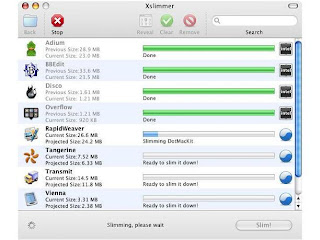 Key Concepts
Key Concepts
- What color will alien plants be? The question matters scientifically because the surface color of a planet can reveal whether anything lives there—specifically, whether organisms collect energy from the parent star by the process of photosynthesis.
- Photosynthesis is adapted to the spectrum of light that reaches organisms. This spectrum is the result of the parent star’s radiation spectrum, combined with the filtering effects of the planet’s atmosphere and, for aquatic creatures, of liquid water.
- Light of any color from deep violet through the near-infrared could power photosynthesis. Around stars hotter and bluer than our sun, plants would tend to absorb blue light and could look green to yellow to red. Around cooler stars such as red dwarfs, planets receive less visible light, so plants might try to absorb as much of it as possible, making them look black.
The prospect of finding extraterrestrial life is no longer the domain of science fiction or UFO hunters. Rather than waiting for aliens to come to us, we are looking for them. We may not find technologically advanced civilizations, but we can look for the physical and chemical signs of fundamental life processes: “biosignatures.” Beyond the solar system, astronomers have discovered more than 200 worlds orbiting other stars, so-called extrasolar planets. Although we have not been able to tell whether these planets harbor life, it is only a matter of time now. Last July astronomers confirmed the presence of water vapor on an extrasolar planet by observing the passage of starlight through the planet’s atmosphere. The world’s space agencies are now developing telescopes that will search for signs of life on Earth-size planets by observing the planets’ light spectra.
Photosynthesis, in particular, could produce very conspicuous biosignatures. How plausible is it for photosynthesis to arise on another planet? Very. On Earth, the process is so successful that it is the foundation for nearly all life. Although some organisms live off the heat and methane of oceanic hydrothermal vents, the rich ecosystems on the planet’s surface all depend on sunlight.
Photosynthetic biosignatures could be of two kinds: biologically generated atmospheric gases such as oxygen and its product, ozone; and surface colors that indicate the presence of specialized pigments such as green chlorophyll. The idea of looking for such pigments has a long history. A century ago astronomers sought to attribute the seasonal darkening of Mars to the growth of vegetation. They studied the spectrum of light reflected off the surface for signs of green plants. One difficulty with this strategy was evident to writer H. G. Wells, who imagined a different scenario in The War of the Worlds: “The vegetable kingdom in Mars, instead of having green for a dominant colour, is of a vivid blood-red tint.” Although we now know that Mars has no surface vegetation (the darkening is caused by dust storms), Wells was prescient in speculating that photosynthetic organisms on another planet might not be green.
Even Earth has a diversity of photosynthetic organisms besides green plants. Some land plants have red leaves, and underwater algae and photosynthetic bacteria come in a rainbow of colors. Purple bacteria soak up solar infrared radiation as well as visible light. So what will dominate on another planet? And how will we know when we see it? The answers depend on the details of how alien photosynthesis adapts to light from a parent star of a different type than our sun, filtered through an atmosphere that may not have the same composition as Earth’s.
Harvesting Light
In trying to figure out how photosynthesis might operate on other planets, the first step is to explain it on Earth. The energy spectrum of sunlight at Earth’s surface peaks in the blue-green, so scientists have long scratched their heads about why plants reflect green, thereby wasting what appears to be the best available light. The answer is that photosynthesis does not depend on the total amount of light energy but on the energy per photon and the number of photons that make up the light. Whereas blue photons carry more energy than red ones, the sun emits more of the red kind. Plants use blue photons for their quality and red photons for their quantity. The green photons that lie in between have neither the energy nor the numbers, so plants have adapted to absorb fewer of them.
The basic photosynthetic process, which fixes one carbon atom (obtained from carbon dioxide, CO2) into a simple sugar molecule, requires a minimum of eight photons. It takes one photon to split an oxygen-hydrogen bond in water (H2O) and thereby to obtain an electron for biochemical reactions. A total of four such bonds must be broken to create an oxygen molecule (O2). Each of those photons is matched by at least one additional photon for a second type of reaction to form the sugar. Each photon must have a minimum amount of energy to drive the reactions.
 Setelah Yahoo dengan logonya 'Yahoo! Green', kini giliran Google mengusung tema peringatan hari 'Erth Day' atau 'Hari Bumi' dengan menampilkan logo unik bergambarkan pemandangan alam dengan bebatuan, yang diapit pepohonan dan dan air terjun, dan di dalam danau kecil yang ada terdapat kura² didalamnya.
Setelah Yahoo dengan logonya 'Yahoo! Green', kini giliran Google mengusung tema peringatan hari 'Erth Day' atau 'Hari Bumi' dengan menampilkan logo unik bergambarkan pemandangan alam dengan bebatuan, yang diapit pepohonan dan dan air terjun, dan di dalam danau kecil yang ada terdapat kura² didalamnya.






